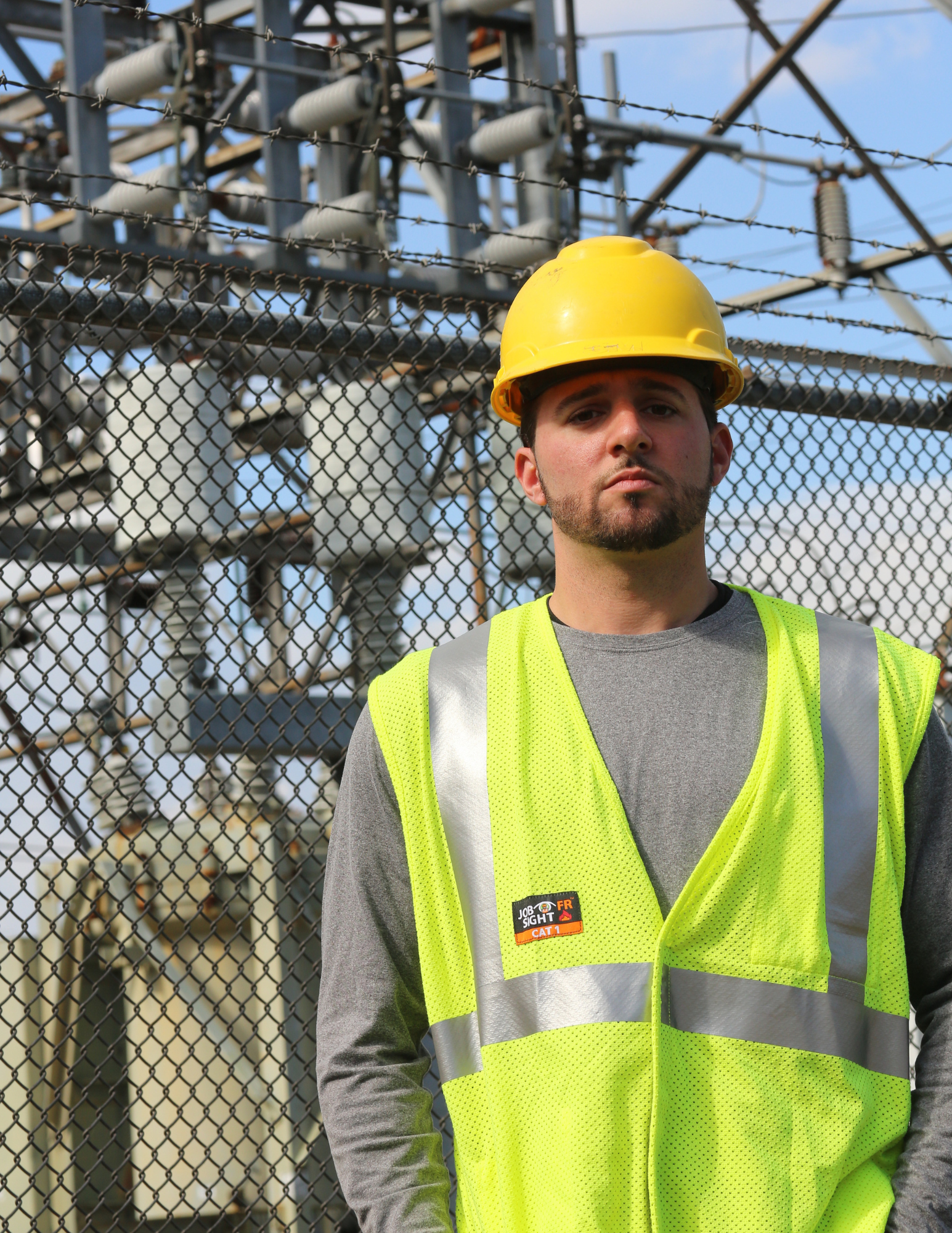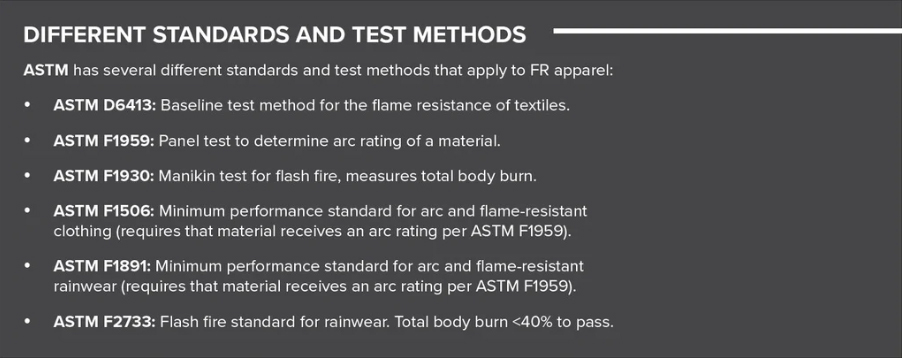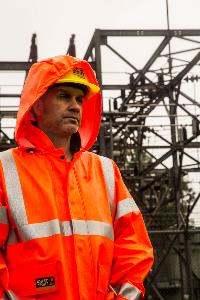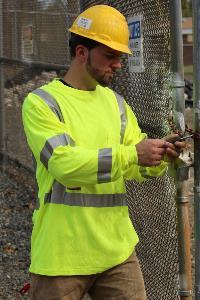Navigating the Complex World of Flame-Resistant Apparel

USES OF FR APPAREL
There are many different uses for FR apparel, depending on the industry. FR apparel—including vests, t-shirts, and rainwear—are commonly used by workers in gas and electrical utilities, petrochemical, construction, off-shore drilling, telecommunications, pipelines, power generation, and general industry.
According to Meg Bowser, Product Manager at Tingley, most of the company’s FR apparel also provides high visibility. FR is a subset of Tingley’s high-vis apparel line, she says.
In a revision of the ANSI/ISEA 107 standard on high-visibility garments, a section was added requiring labels to say FR or non-FR, Bowser says. Companies were coming out with FR vests that were at a much lower price point than a true FR product, but they were just a treated polyester and when exposed to an arc or flash, “the thing would catch fire,” she adds. “It would melt, it would make a mess, and they would market them as FR vests. People would buy them thinking it was a completely different level of protection than they actually needed.”
As a result, the high-visibility products group added the labeling section in the standard, saying if you want to be labeled as FR, you’d have to meet these particular requirements, says Bowser. “So if it is a treated product, it now has to say non-FR,” she adds. “It brings up the question at least, so people see that label. Maybe they only need that treated product…We’re not making any of those treated products, so from our perspective people who are coming and looking at our products are already getting that higher level of protection.”
Tingley has some rainsuits that provide limited FR protection, she notes. “Some people are welders who just have some sparks flying. They just want to make sure that they don’t catch fire, but they don’t need the same level of protection so they don’t need to pay a higher price for that,” says Bowser. “So something like that has definitely got its uses, it’s got its place in the industry. We don’t want to get rid of it completely, we just want people to actually know what they’re getting.”
Tingley has worked to inform customers about its FR apparel.
“It’s just an education issue and getting it out in the industry,” Bowser says. “So when we first put it out there a couple of years ago, we got the question a lot. People are getting used to it, people understand the difference better.”
Tingley has posted marketing pieces on its website about high visibility and FR apparel.

“Different standards protect against different flame hazards,” Bowser says. “Arc flash is going to come more at you. The product will char and carbonize and protect the person wearing it. Non-FR apparel can melt and drip; the person is experiencing second- or third-degree burns and have molten material dripping into those wounds.”
If there’s a petrochemical flash fire with gas vapors in the air, and there’s a spark and something ignites, that forms a chimney effect and that vapor will all ignite in the air, she adds. “If your rainwear is not sealed off properly, you can get flames up inside the garment. Different hazards require different types of protection.”
It takes a lot of work to differentiate between all the different standards and test methods.
“There are a lot. We’ve been dealing with them for a long time,” says Bowser. “We’re a voting member on many of the committees. Our technical services manager attends those meetings and keeps us informed if there are any changes; I go to the ANSI meetings and keep him informed of changes there.”
That experience keeps the company on top of the latest developments, she says. “You’re around them long enough, you kind of absorb all of them but to somebody who’s not used to it, it’s a lot of letters and numbers,” adds Bowser. “We have some informational pieces we put together to distribute for our sales team to help people keep it straight.”
Changes to the standards tend to be minor revisions or clarifications to language. “Every time there’s a revision, you have to change the year on the label,” she says. “Whenever a revision comes out, you have to retest all fabrics and products and make sure you’re meeting them.”
Proposals for changes can be brought up at the committee level and can come from “testing labs on the committees, manufacturers, people making the fabrics…you have a lot of perspectives coming together,” Bowser says. “Sometimes it’ll come from an end user who submits a lot of questions.”
“Generally, they tend to know what kind of hazards they’re trying to protect against,” she notes. Companies should conduct hazard analysis at their work sites to determine the proper protection.
“There can be some confusion,” says Bowser. “Clothing and rainwear can have different standards, requirements for fabrics.”
 There are a lot of different layers of primary protection for workers, but Tingley has focused on high-visibility apparel. “Most of what we do right now is high visibility, but we do a lot of the secondary apparel like the rainsuit. You wear your primary PPE every day; if it’s raining, you’re adding that layer on,” she adds.
There are a lot of different layers of primary protection for workers, but Tingley has focused on high-visibility apparel. “Most of what we do right now is high visibility, but we do a lot of the secondary apparel like the rainsuit. You wear your primary PPE every day; if it’s raining, you’re adding that layer on,” she adds.
“It’s a secondary layer you’re not wearing under all circumstances that just needs to not make anything worse if you encounter a situation like an arc flash,” Bowser says. “It needs to not further the extent of the injury but it doesn’t need to add another additional level of protection because you’re already meeting that with the gear you’re wearing underneath.”
View Flame Resistant Apparel Guide
HEAT STRESS
Heat stress in the workplace is a serious concern. The federal government is working on a heat stress standard, while several states have enacted their own measures to protect workers from the dangers of working in hot conditions. Providing workers with protection against heat stress has moved to the forefront, and FR apparel is designed to help with that.
“We get requests for breathable products,” says Bowser. A mesh vest provides more ventilation, while rainwear with a vented cape back can provide more breathability.
The biggest request Tingley gets from people in terms of heat stress is for items to be lighter weight, she adds.
“They’re looking for something that’s breathable but obviously it’s going to drive costs up,” Bowser says. “You’re trying to protect against flame hazard and something coming through your suit. And you’re going to make it breathable but it’s a more porous coating so it is making it easier for things to get inside. It is a balancing act on that side.”
INNOVATIONS IN FR TECHNOLOGY
Innovation is constantly evolving with FR apparel. “There always will be new hazards and products to deal with those,” says Bowser. “From technical perspective, the companies that manufacture materials that go into the construction of the garments are evolving all the time. They’re creating new fibers, they’re weaving fabrics together in new ways, they’re creating different coatings and different weights of fabrics and altering that can go up against different levels of protection.”
This provides new possibilities for apparel. “As the fabric side evolves, it gives us more options and things to play around with to assemble the garments themselves,” she says.
As materials have improved, the look of the apparel has as well. “The look has gotten better,” says Bowser. “Especially with rainwear. Those materials were very stiff, very boardy…We’ve revamped our suits a couple of times with new fabrics to make them softer and more comfortable.”
The newer products keep the level of protection but also manage to make the materials softer, more flexible, and more lightweight, she adds.
 “FR clothing has definitely evolved over the years,” Bowser notes. “Standards are always being revised and updated and the products in the market reflect those changes,” she says.
“FR clothing has definitely evolved over the years,” Bowser notes. “Standards are always being revised and updated and the products in the market reflect those changes,” she says.
“Technology has improved considerably,” says Bowser. “Years ago, the limited FR requirements were a char length of less than 6 inches and flameout of less than 2 seconds, so it’s pretty basic to be the primary FR standard,” she adds. “And now we’ve evolved to arc flashes and flash fires and much higher levels of hazards than we ever used to.”
Looking to the future, Bowser doesn’t see radical changes to the styling of FR garments.
“Many designs are classic and functional,” she says. “Most of the advancements we’ll see will be related to the advancements of the materials and getting more technical fabrics that provide more protection at a lighter weight.”
This article was developed by Tingley in partnership with the Simplify Media Group editorial team.
Connect with Saf-T-Gard to Learn More
Industrial safety is our legacy going back 9 decades. For an overview of our Tingley clothing, including and to order for immediate shipment, please visit Tingley.

